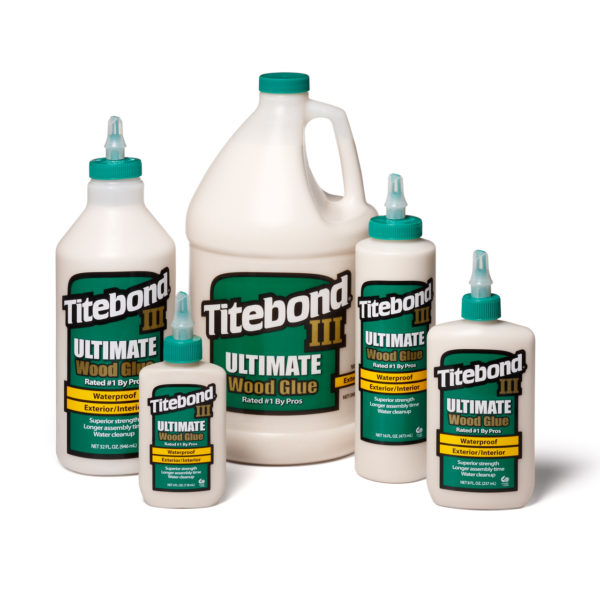
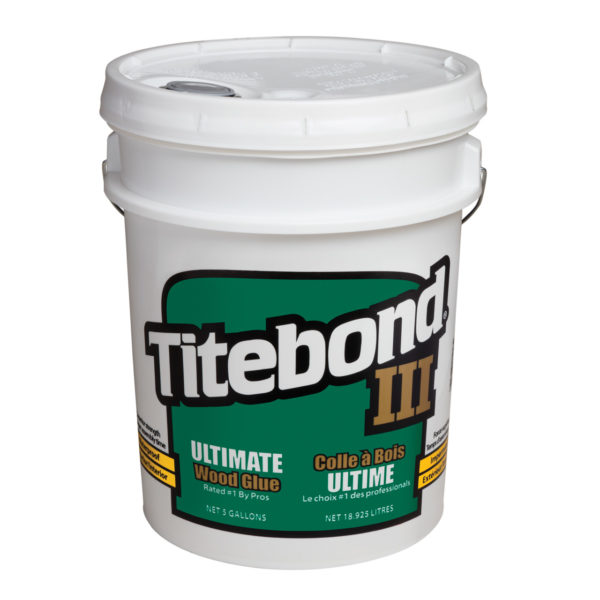
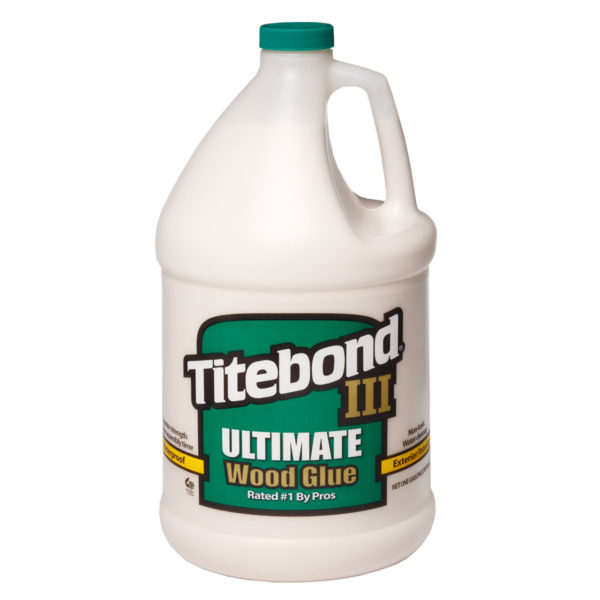
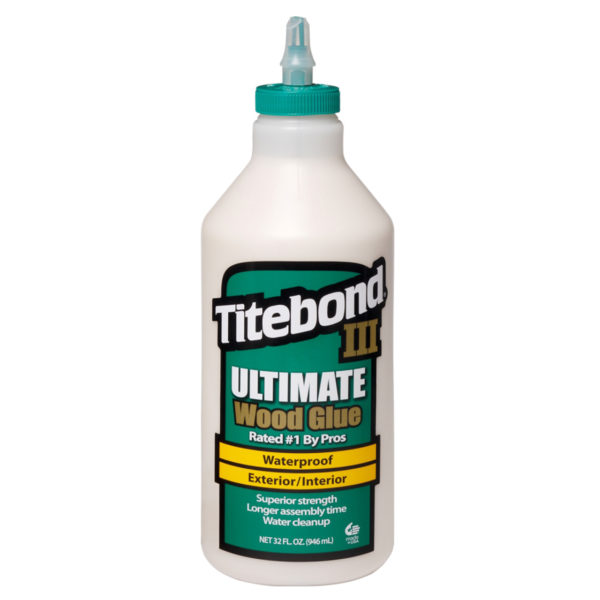
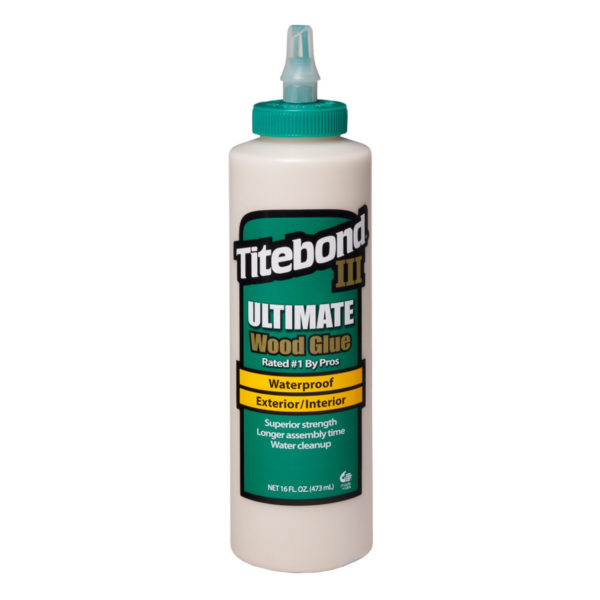

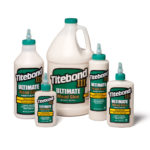
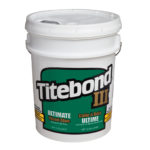
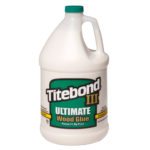
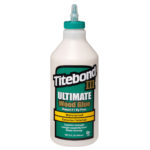
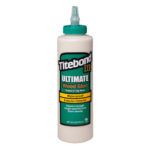
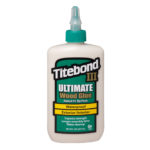
Titebond III Ultimate
Titebond III Ultimate is the most advanced wood glue available today. While all Titebond products provide superior performance, Titebond III is especially useful for outdoor applications in cooler temperatures or when concern for substantial moisture calls for the use of a Type I glue (USA boil test). For interior applications, the longer working time of Titebond III provides woodworkers the necessary latitude to ensure that substrates are precisely aligned before being bonded. Overall, Titebond III combines superior strength, sandability with water cleanup the ease of use of aliphatic resins with the, durability and water resistance of polyurethanes into one easy-to-use formulation.
Where to buyFeatures
- Passes ANSI/HPVA Type I water-resistance and D3 european standard ( passes the USA boil test)
- Waterproof formula that cleans up with water
- Superior strength – Strong initial tack (has the highest bond strength of the cross link PVA)
- Designed for interior and exterior applications
- Longer open assembly time
- Lower application temperature
- Unaffected by finishes
- FDA approved for indirect food contact
Resources
- MSDS (PDF, 128.29kB)
- Data Sheet (PDF, 796.90kB)
| Part number | Size | Weight | UPC | Case UPC | Units per package | Packages per pallet |
| 511413 | 237ml | 0.30kg | 037083014136 | 10037083014133 | 12 | 160 |
| 511414 | 473ml | 0.57kg | 037083014143 | 10037083014140 | 12 | 100 |
| 511415 | 946ml | 1.18kg | 037083014150 | 10037083014157 | 6 | 88 |
| 511416 | 3.785lt | 4.44kg | 037083014167 | 10037083014164 | 2 | 63 |
| 511417 | 19lt Pail | 22.2kg | 037083014174 | 1 | 24 |
| Type | Advanced Proprietary Polymer |
| State | Liquid |
| Colour | Tan |
| Dried film | Light Brown |
| Solids | 52% |
| Viscosity | 4,200 cps |
| Storage life | 24 months in tightly closed containers below 24°C |
| Calculated VOC | 9 g/L |
| Weight per gallon | 4.17kg |
| Chalk temperature | Approximately 7°C |
| Flashpoint | > 93°C |
| Freeze/thaw stability | Stable |
| pH | 2.5 |
The standard includes product performance requirements and environmental and health requirements such as reduced toxicity, hazardous ingredients, and volatile organic compounds (VOCs).
Bond strength ASTM D905 (on hard maple)This test method covers the determination of the comparative shear strengths of adhesive bonds used for bonding wood and other similar materials, when tested on a standard specimen under specified conditions of preparation, conditioning, and loading in compression. This test method is intended primarily as an evaluation of adhesives for wood. This specification is designed to cover comparative shear strengths of adhesive bonds used for bonding wood or other similar materials, when tested on a standard specimen under the subscribed conditions of preparation, conditioning and loading in compression. This test method is intended primarily as an evaluation for wood adhesives
Bond strength ASTM D4236This practice describes the standard procedure for developing precautionary labels for art materials to provide chronic health hazard and precautionary statements based on knowledge that exists in the scientific and medical communities. These statements concern hazards known to be associated with a product or product component(s) when it is present in a physical form, volume, or concentration that in the opinion of a toxicologist has the potential to produce a chronic adverse health effect
Bond strength ASNI/HPVA Type I Water-Resistance : Wood gluesType I testing is a Boil test and involves cutting the 150 x 150mm block assemblies into 25 x 75mm specimens, boiling them for 4 hours, then baking in a 145°F oven for 20 hours. They are boiled for an additional 4 hours, then immediately cooled using running water. The specimens are sheared while wet, and the bonds must pass certain strength and wood failure requirements to pass the Type I specification. Also Similar to D3 European standard testing.
Bond strength ANSI/HPVA Type II Water-Resistance : Wood gluesType II testing is a soak test, involving cutting the 150 x 150mm glued block assemblies into 50 x 125mm specimens, soaking them for 4 hours, then baking in a 120°F oven for 19 hours. This is repeated for a total of three cycles, and the bonds must not de-laminate to pass the Type II specification. Also similar to D2 European standard testing.
Application Temperature
Above 8.33°C.
Open Assembly Time
8-10 minutes (21.1°C./50%RH)
Total Assembly Time
20-25minutes (21.1°C./50%RH)
Minimum Required Spread
Approximately 6.18 square meters per litre
Required Clamping Pressure
Enough to bring joints tightly together (generally, 100-150 psi for softwoods, 125-175 psi for medium woods and 175-250 psi for hardwoods)
Method of Application
Plastic bottles for fine applications; glue may also be spread with a roller spreader or brush.
Cleanup
Damp cloth while glue is wet. Scrape off and sand dried excess.
Not for continuous submersion or for use below the waterline. Not for structural or load bearing applications. Use when temperature, glue and materials are above 7.22°C. Store product below 23.8°C. Storage above this temperature may cause product to thicken and reduce the usable shelf life. If thickened, shake vigorously by firmly tapping bottle on a hard surface until product is restored to original form. Because of variances in the surfaces of treated lumber, it is a good idea to test for adhesion. For best results gluing exterior doors or exotic and oily woods, please contact out Technical Support Team at 1-800-347-4583. Read MSDS before use. KEEP FROM FREEZING. KEEP OUT OF THE REACH OF CHILDREN.
No caution information is needed. Please refer to the Safety Data Sheet for further information.